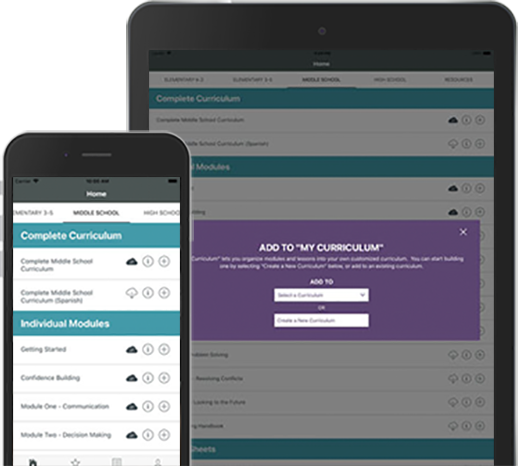Test-Taking
Posted: May 2, 2018The stress of taking a test can overwhelm even the most prepared student, and the level of their anxiety can increase significantly as they get closer to end-of-the-year testing. But by teaching students how to manage their time, take effective notes, develop a positive attitude, and more, we can make certain that they have the skills necessary to ease their level of stress and approach each exam with confidence.
The following lesson is from Module Six: Skills for School and Beyond of our High School Level curriculum (page 345). Middle school educators can use the “Taking Tests” lesson from Module Five: Studying Effectively of the Middle School Level curriculum (page 309). Both modules are available for download by logging in to your account.
PREPARING FOR TESTS AND EXAMS
AGENDA
Starter
Studying: Getting Ready
Test Day
Showing Off What You Know: Game Show
Conclusion
Questions for Assessment
OBJECTIVES
- Students will recognize the importance of preparing for tests.
- Students will identify strategies for preparing for tests and examinations.
- Students will practice techniques for effective test taking.
MATERIALS NEEDED
- One copy of the “Test-Taking Self-Assessment” activity sheet for each student (Starter and Part I)
- An overhead transparency made from the “Test-Taking Self-Assessment” activity sheet (Part I)
- One copy of the “Game Show” activity sheet for each student (Part III)
STARTER (6 Minutes)
Tell students that you are going to give them an opportunity to reflect on something that they have been doing for years: taking tests. In your usual manner, tell students that they are about to take an important pop quiz. Have them clear off their desks. Distribute the “Test-Taking Self-Assessment” activity sheet. Once students have had a chance to read it, tell them that this exercise will not be graded. Have students complete the activity sheet, keeping in mind how they felt when you announced the pop quiz.
PART I — STUDYING: GETTING READY (15 MINUTES)
Purpose: Students recognize the importance of preparing in advance for a test.
Students discuss their views on taking tests.
Discuss student responses to question one on the activity sheet. Let students share their feelings about taking tests. Mention that people can improve their attitude toward test taking if they think of a test as an opportunity to demonstrate what they know.
Students recognize the impact that preparing for a test has on their attitude.
Talk about question two. Ask students why some of them might have felt anxious about taking this test. Ask, “Would your reactions have been different had you received advance notice?”
Point out to students that although the material on a pop quiz might be the same as on an announced test, a pop quiz often causes more anxiety because students don’t have an opportunity to prepare. Elicit from students the awareness that preparing in advance for an exam helps to decrease anxiety.
Students recognize the impact that preparing for a test has on their performance.
Discuss question three. Invite students to share how far in advance they usually prepare for a test. Suggest to students that they could prepare for a test as a runner prepares for a marathon: A marathon runner begins training well in advance of a race. Gradually, the runner builds endurance, running longer and longer distances. Finally, it is the day of the race. The runner is confident that she or he is ready and able to complete the race at peak performance.
Challenge students to relate preparation for a marathon with test preparation. Explain to students that just as with training for a marathon, people perform their best on exams when they allow themselves plenty of time to prepare.
Students identify effective study practices.
Talk about question four. Encourage students to share specific ways that they prepare for an exam. Record student responses on the board or on an overhead transparency. (Students might respond: taking good notes in class, staying organized, making note cards or flashcards.)
Elicit from students that study sheets can be extremely useful when preparing for a major exam, especially the following two types of sheets:
- A “key terms” sheet, which contains dates, names, events, places, and other specific facts that need to be memorized
- A “general themes” sheet, which groups and outlines major ideas or recurring themes that must be reviewed
Point out that the key terms study sheet is useful when preparing for short-answer tests, while the general themes sheet enables students to organize information that might appear in essay questions. Suggest to students that they should prepare study sheets five to seven days before a major test.
Discuss with students the usefulness of mnemonic devices for remembering key terms. Explain that mnemonic devices are tricks to enhance memory. For example, some people remember the order of the planets with a sentence like “My very entertaining mother just served us nachos” (Mercury, Venus, Earth, Mars, Jupiter, Saturn, Uranus, Neptune). Elicit from students examples of mnemonic devices that have been helpful to them in the past.
Remind students that in the first lesson of this module they identified their learning styles and discussed techniques for studying that complement their learning style. Explain that mnemonics, study sheets, and even study groups are adaptable to various learning styles.
Students identify advantages and disadvantages of studying in groups.
Take a poll of students who get together with friends to study. Elicit from students the advantages and disadvantages of this method. Record their ideas on an overhead transparency or on the board. (Advantages include: learning from one another, in-depth discussions, steady studying schedule, makes studying more fun. Disadvantages include lost time if friends are not prepared, panicky students spread test anxiety to each other, groups may use time more inefficiently than one person alone, more distractions in groups.)
Conclude with students that choosing the right people to study with is important.
PART II — TEST DAY (15 MINUTES)
Purpose: Students identify effective test-taking strategies.
Students recognize that it is important to relax and sleep well the night before an exam.
Ask students to imagine that it is now the night before an exam. Have students suggest useful pretest activities. Point out that they should have done most of their major studying already, and that, ideally, all they need is a brief review. Lead students to understand that the most important thing that they can do the night before an exam is to relax and get a good night’s sleep.
Students brainstorm effective pretest strategies.
Divide the class into groups of four or five. Give students the following instructions:
- Each group needs a sheet of writing paper.
- At my signal, one student in each group will write down one pretest strategy. This can be anything you do from the time you wake up until the minute before the exam begins.
- That student then passes the paper to the student on his or her right, who adds a different strategy to the list.
- Continue to pass the paper around the circle.
Give the groups two minutes to list as many pretest strategies as they can. The paper can go around the circle more than once. (Students might respond: eating a good breakfast, being on time, dressing in comfortable clothing, bringing all materials needed for the test [e.g., sharpened pencils, pens, scrap paper, calculators], bringing a watch, arriving a minute or two early to quickly review notes, avoiding talking to anxious students.)
Students brainstorm effective test-taking strategies.
When two minutes have passed, instruct students to take two more minutes to write down as many test-taking strategies as they can. Groups should again pass the paper around the circle and include ideas from each member. (Students might respond: looking over the entire test first, budgeting time, reading directions carefully, reading each question carefully, watching the time, circling difficult questions and coming back to them.)
Students discuss the strategies identified by their groups.
When two minutes have passed, have the groups discuss the pretest strategies. Compile the groups’ ideas on the board or transparency, and add other ideas they might have missed.
On a separate list, compile students’ test-taking strategies and add any that are missing. Duplicate the lists and distribute them to students for their future reference.
Students discuss strategies to reduce anxiety.
Ask students how many are anxious before or during a test. Explain that test anxiety is very common, but that there are some simple things that they can do to combat it. Encourage students to offer suggestions. (Students might respond: being well prepared, taking deep breaths, thinking calm thoughts.)
PART III — SHOWING OFF WHAT YOU KNOW: GAME SHOW (12 MINUTES)
Purpose: Students learn and recall pretest and test-taking strategies in a game-show style activity.
Students participate in a game-show style activity.
This activity provides an opportunity to reemphasize strategies that might be particularly important to your students. Use the questions and answers on the “Game Show” activity sheet (#12) as you facilitate the game.
Divide the class into two or more teams. Tell students that you will read questions out loud. The teams should raise their hands as soon as they know the answer. Call on the first team to raise their hands.
Begin the activity.
CONCLUSION
Ask students to identify three strategies that they use to prepare for and take tests. Elicit from students the following key points that were taught in this lesson:
- Preparing in advance for an exam helps to decrease anxiety and increase the likelihood of success.
- Study sheets are useful when compiling notes in preparation for a major exam.
- Specific test-taking strategies can be applied during an exam to improve performance.
QUESTIONS FOR ASSESSMENT
- What are your usual strategies for test preparation in the week leading up to a test? What can you do to make your preparation more effective?
- List three mnemonic devices that you find effective.
- List five test-preparation techniques that can help you get ready the day of a test.






